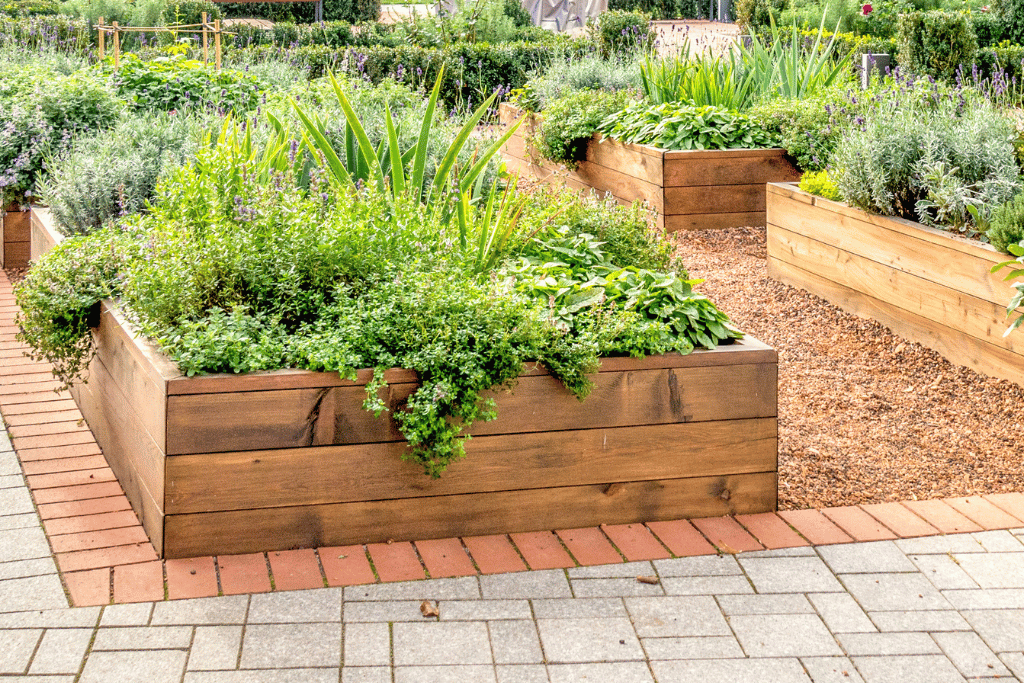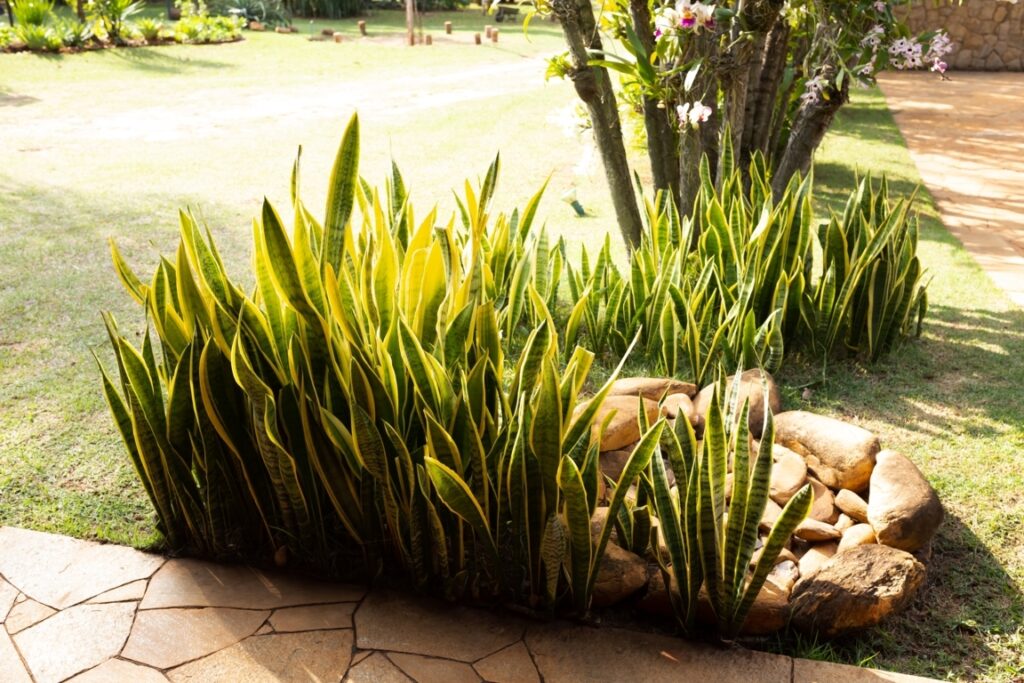
People often move houseplants outdoors. This can be for aesthetics, because of space constraints, or for plant growth improvements. Not all houseplants will survive such a move. However with proper care and consideration and in the right climate, you can make it possible. And, this goes for the mother-in-law’s tongue, aka the snake plant.
Snake plants make excellent houseplants. How about moving them outdoors to decorate your porch or garden? Can snake plants live outside? Let’s find out!
Can Snake Plants Live Outside?
Snake plants are unique, beginner-friendly plants. They are simple to grow and need very minimal care. They are often grown as houseplants. But you can also grow them outdoors.
Snake plants will thrive outside in the right temperature. They flourish under bright indirect sunlight and warm conditions. Be careful in cold climates, as freezing temperatures harm plants. Ensure the outside temperature is between 55 to 90° Fahrenheit. You can grow snake plants outside in the right climate, with indirect sunlight, and with moderate watering.
Are we clear on the possibility of growing snake plant outdoors?
Great!
Now, let’s go into detail to ensure your snake plant survives its move…
How to Take Care of Snake Plants Outdoors?
Even though growing snake plants outside is easily achievable, it’s always better to be cautious.
Snake plants love sunlight, but too much sunlight can burn them. Similarly, they flourish in warm temperatures, but when winter arrives, things mess up.
Too much of a contradiction, isn’t it?
No worries. Growing snake plants outdoors is possible, provided you know how to take care of them in their new environment. Here are some aspects to consider while you grow your snake plants outdoors.
Temperature Range
Temperature differences can influence plant growth. And the slender leaves of the snake plants are no exception.
Snake plants are tropical plants native to West Africa. They are sensitive to extreme temperatures. Too much heat burns their leaves, while cold temperatures can kill them. They flourish best in warm climates and are very sensitive to cold. This makes it challenging to manage them outdoors during the winter.
What is the best temperature to grow snake plants?
Snake plants thrive best at a temperature range between 55 to 90° Fahrenheit. This range allows them to grow and propagate abundantly. Slight fluctuations in the temperature won’t have any drastic effect over their lifecycle. But, the prolonged temperature drops below 50° F can be disastrous.
Light

Another vital factor influencing your snake plant’s growth is light!
Even though snake plants can grow in dim and brightly lit spaces, they flourish better in bright, indirect lighting.
When you grow snake plants as indoor plants, you have controlled lighting. But, once you transfer them outside, things change. Both the intensity and the duration of sunlight varies. It would be best to put extra time into observing and inspecting leaves for any foliage damage.
Can snake plants grow in direct sunlight?
No. You must avoid growing snake plants in direct sunlight. The sun’s rays are intense and damage the fragile leaves of these plants. Exposing them to intense sunlight for long periods can result in scorched and wilted leaves.
Similarly, too much shade can affect these plants. The foliage of snake plants will begin to droop and wither away.
How much sunlight do outdoor snake plants need?
Aim for at least 5 hours of bright indirect sunlight. The more sunlight, the better their growth will be as long as it’s not too hot, or too intense.
Watering
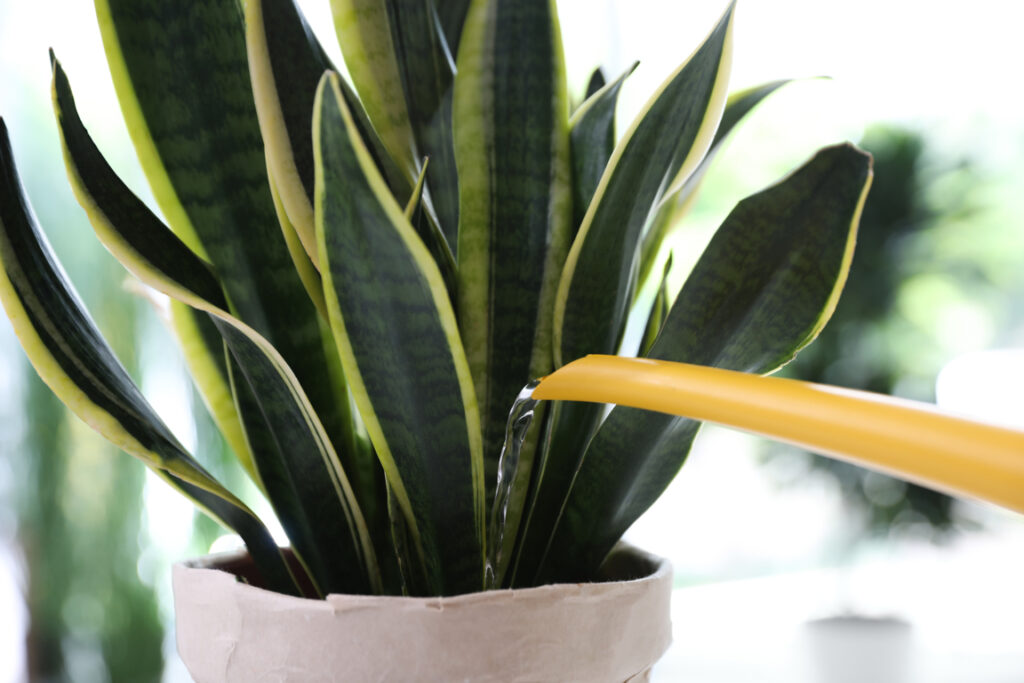
Overwatering will be the quickest way to kill your plant. I am not kidding!
Water them only when you sense soil dryness. The plant’s fleshy leaves usually store water and don’t need extra hydration. The frequency of watering depends primarily on the growing conditions. Outdoor plants appreciate more water during warm seasons than cold seasons.
Another aspect that influences a snake plant’s watering routine is its location. Watering needs will vary based on whether they are indoor or outdoor, potted or ground growing, and any surrounding tree water requirements, etc.
Check your snake plant’s soil moisture and water them when they dry out. The presence of yellow and wilted leaves signifies they are suffering from a lack of water.
Check your snake plant’s soil moisture and water them when they dry out. The presence of yellow and wilted leaves signifies they are suffering from a lack of water.
Soil
Use well-draining, aerating, and nutrient-rich soil. A big problem with snake plants is root rot. So, prevent water clogging by opting for a free-draining potting mix. Instead of choosing a general potting mix, you can opt for a soil mix specific to succulents or snake plants.
Ensure your plant pots have drainage holes. You also use terracotta pots to help with fast draining and quick moisture absorption.
Repotting
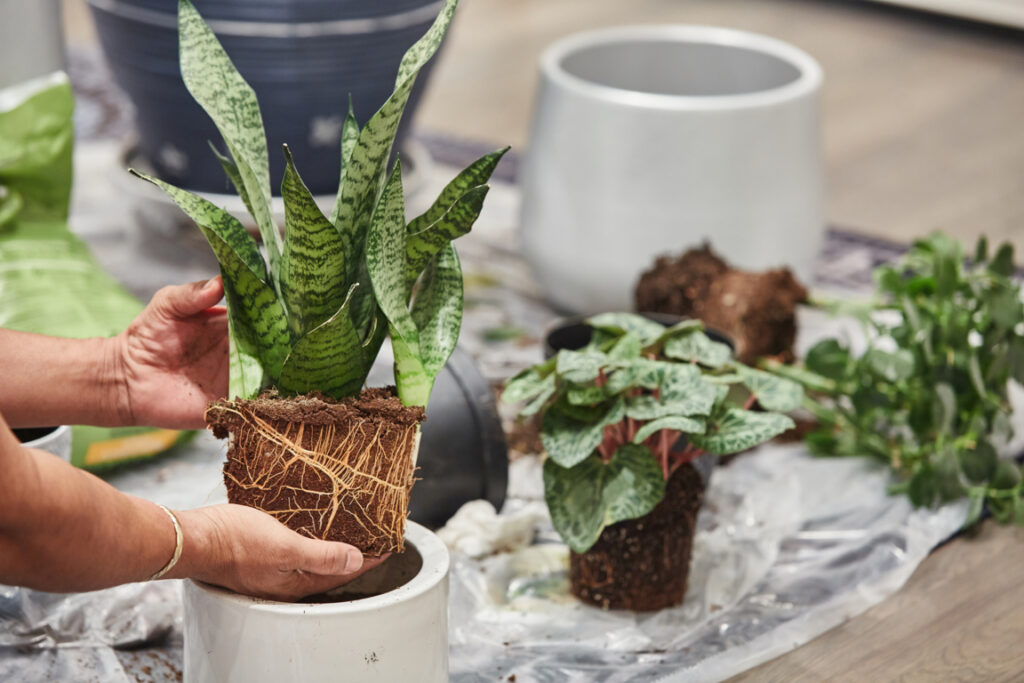
Snake plants are slow-growers. Depending on their growth and sunlight exposure, you can estimate the frequency of repotting. Low-lit plants grow slowly and need repotting every five to ten years. In contrast, well-lit plants grow fast and need repotting every three to five years.
Signs you need to repot a snake plant include:
- Increase in root growth visible on the soil surface or through the drainage holes
- Quick water drainage from the pot when watering
- Signs of rotting bottom leaves due to poor drainage
- Overcrowding of leaves
- Pot damage or cracks
Location
Considering where and when to place snake plants outdoors is essential to protect them from extreme climates. Never keep them directly under intense hot sunlight. Instead, opt for semi-shady spots. Placing them under a tree or beside a porch can provide bright, indirect sunlight. Avoid south-facing locations to prevent exposure to intense heat and cold drafts.
Outdoor pests

Snake plants are usually quite pest-resistant. But, a lack of care or unfavorable conditions can lead to pest infestation.
Mealybugs, spider mites, aphids, whiteflies, etc., are common outdoor pests. Use neem oil or rubbing alcohol over the leaves to remove these pests. Treat pests immediately; if not, these pests will feed on and destroy your snake plant’s leaves.
Moving Snake Plants from Indoors to Outdoors
Snake plants are incredible houseplants. They flourish best indoors, under bright indirect sunlight. But shifting them to an outdoor setup is challenging. These sudden changes in the environment will shock the plant. You must give them enough time to adjust gradually to those outdoor conditions.
There are so many differences between indoor and outdoor plant requirements. Every aspect that was mild and controllable indoors will become intense and wild in the outdoors. Factors like sunlight, temperature, and watering can drastically change. Optimizing your plant’s location and care can help you control the effect of these environmental changes.
Consider moving snake plants outdoors during warmer seasons. Ensure any changes are gradual and do not deteriorate the plant’s growth.
- Start by moving your snake plants near a window. Let them get used to the higher intensity of light and temperature.
- Now, slowly increase the watering pattern and volume.
- Once the plants adjust, move them outdoors, but keep them in complete shade. This slowly increases the plant’s endurance in outdoor climates.
- Increase their water intake again. Now the plant’s need for water increases with direct sunlight. Hydrating plants can speed up the adjustment to outdoors, their growth, and it will balance plant moisture levels and reduce stress.
Once all settled, your snake plants can effortlessly thrive outdoors. Keep them under indirect sunlight within their suitable warm temperature range to increase their longevity. Depending on your location, you may need to move your snake plant back indoors when it gets cooler.
And there you go!
Moving your snake plant outdoors is more manageable than you expected. Isn’t it?
Outdoor Snake Plant Care: Things to Avoid
Snake plants thrive on neglect. Despite being so easy to care for, there are a few pointers to consider while you shift them outdoors. Here are a few mistakes to avoid while growing them outdoors.
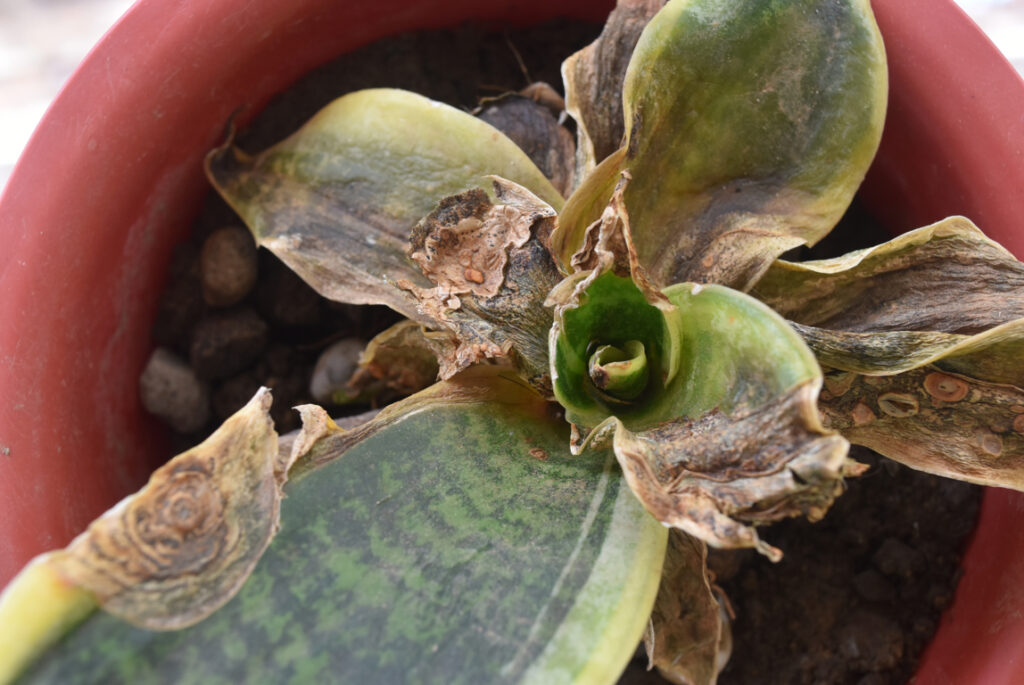
Cold Temperatures
Snake plants hate cold temperatures. Any temperature drop below 50° F is harmful to them. To grow them outdoors, have a backup plan for the winter. Opt for a small greenhouse or shift your plants indoors during winter.
Direct Sunlight
Snake plants thrive in indirect sunlight. Their leaves are very fragile and won’t withstand high temperatures. Placing them under direct sunlight will only burn them. Avoid direct sunlight to prevent yellow and wilted leaves.
Misting
Snake plants are tropical plants that thrive in drought conditions. The fleshy leaves of these plants always have some water reserves. Hence spraying water over them will only lead to fungal infections. If the soil is dry, hydrate the plants only at their soil level and never wet the leaves.
Outdoor pests
Unlike growing them indoors, pest infestation is a greater risk when you grow them outdoors. Hence avoid ignoring any signs of pest infestation. Take action immediately.
Windy spots
Snake plants are tall. The slender leaves of the snake plants can grow up to eight to 12 feet. Wind can damage their long foliage or even topple over small potted snake plants. Avoid placing snake plants in windy locations.
Growing Snake Plants Indoor vs Outdoors
Now that we are clear on the possibilities of growing snake plants outdoors let’s bifurcate the differences between indoor and outdoor setups.
| Aspects | Indoors | Outdoors |
| Benefits | Natural air purifier | Very easy to maintain |
| Drawbacks | Slow growth | Extreme hot and cold temperatures |
| Temperature | Controllable | Uncontrollable |
| Watering | Less watering– once in two weeks | Moderate watering– once or twice every week |
Growing snake plants indoors or outdoors both have their equal share of benefits and risks. Choose the best option for your climate and local environment.
In Conclusion – Can Snake Plants Live Outside?
Well, my dear friend, it’s 100% possible to grow them outdoors.
Snake plants are an incredible addition to your garden, porch, or terrace. Instead of growing them as houseplants, you can enjoy their lush growth, easy maintenance, and aesthetic qualities when you grow them outdoors.
Frequently Asked Questions (FAQ)
How big do snake plants get?
Snake plants can grow eight to 12 feet when grown outdoors. Indoor plants can reach between one to four feet. Some indoor snake plants reach up to eight feet when grown under favorable conditions.
Is a snake plant an outdoor or indoor plant?
Snake plants grow in both indoor and outdoor setups. They are easy to care for and require indirect sunlight to improve their growth rate. Due to the abundant sunlight, snake plants grow faster when planted outdoors.
How can you make snake plants grow faster?
Indirect sunlight and watering can speed up the growth of snake plants. While growing them outdoors, ensure you pick a brightly lit spot. Hydrating them under bright sunlight can accelerate photosynthesis and help snake plants grow faster.
Can snake plants live outside in winter?
Snake plants do not live outside in winter. They are sensitive to cold temperatures and drafts. Keeping them outdoors below 50° F for several days can harm the plants’ health. If you live in a cold region, consider shifting your snake plants indoors or use a small greenhouse set up during milder winters.
Can snake plants live outside in summer?
As snake plants are African natives, they thrive in warm summer climates. Growing them in the summer is easy, provided you keep them safe from direct sunlight. Along with proper care, watering, and a longer duration of indirect sunlight, the snake plants grow faster in the summer seasons.
Where is the best place to put snake plants?
There are two considerations to remember while you plant the snake plants outdoors. The intensity of sunlight and wind direction. Opt for spots having indirect sunlight and low wind flow. Avoid south facing directions to get the best results.
Why is my snake plant dying outside?
Outdoor snake plants decline due to many reasons. But the most common reason is overwatering. Slow-draining soils and lack of sunlight can cause root rots and wilted yellow leaves. And also, check if the optimum temperature is above 55° F.


